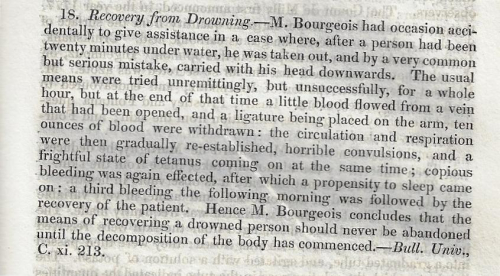JF Ptak Science Books Quick Post
It turns out that the great scientific periodical Quarterly Journal of Science, Literature, and Art1 (a journal that would soon become the Philosophical Magazine of the Royal Society) besides being an important medium for communicating scientific (and occasionally mathematical) work was also filled with other sorts of bits of information, an example of which follows. In this case a report on a drowning is made, the drowned man recovered, seemingly lifeless, and after the normal procedures had been performed remained null and void, at which point a little "bleeding" was performed. "Bleeding" was "bloodletting", an ancient practice, several thousand years old,. where a certain amount of blood is taken from the patient, the belief being that it would remove the bad elements in the body/blood. In this case, in the first application, ten ounces was removed. Ten ounces is not that much, less than a pint, which is what people donate at a blood clinic--the human body can spare that much, easily, as it contains some 180 ounces or thereabouts on average. Two further bloodlettings were administered, pulling out "copious" amounts of blood, whatever that means. (Perhaps they let 30 ounces, perhaps double that, I don't know--that would make 3-4 or more pints, which if lost at once would be a challenge for an EMT.
The extraordinary thing here is that after being drowned, and three bloodlettings, and being unconscious overnight, the man woke in the morning, revived.
I wasn't prepared for the author's revelation of the big lesson learned here, which I thought was going to be about bloodletting. Rather we are told that the significant thing is to never give up on your patient--especially in the unconscious victim--until the body putrefies ("until decomposition of the body commenced").
Notes
1. The Quarterly Journal of Science, Literature, and Art, July-December, 1827; London, printed by Henry Colburn, p 231.



Comments